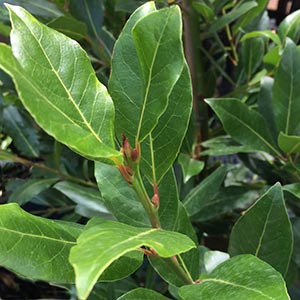
Laurus nobilis, Bay Laurel or Bay Tree
Best known as the tree that produces Bay Leaves, Laurus nobilis also makes a good evergreen garden plant. Attractive green foliage year round is the main feature.
If you are looking for a hedge with a difference then a BayLeaf Hedge may be for you. Its fragrant, very hardy once established, fragrant foliage and will grow in full sun to a little shade. It can also be pruned to a low hedge of around 1m or a taller hedge to 3 metres plus.
This is a very upright tree that will reach a height of 5 – 7 metres over time.
Laurus nobilis is available for sale in a number of forms and cultivars as well as a standard for. A hardy, drought tolerant and salt tolerant tree ‘Mile’s Choice’ – Mile’s Bay Laurel is a widely sought after form.
Often grown in the kitchen garden where it can be grown as a standard with other plants growing below. Although used widely for culinary purposes L. nobilis (Bay Tree) also make a great hedging plant.
Varieties
- L. nobilis ‘Saratoga’ is the Sweet Bay.
- L. nobilis angustifolia is the Narrow Leafed Bay or ‘Willow Bay’.
- L. nobilis ‘Mile’s Choice’ is a more compact form.
How To Grow and Care For Laurus nobilis
- Water:
A humus rich moist well-drained soil is best. Water deeply during long dry periods. Soil should be moist but never soggy or waterlogged.
Allow the soil to dry a little between watering to prevent root problems. It can tolerate short periods of drought but benefits from regular watering. - Sun:
Best grown in full sun to partial shade. - Soil:
Garden soils that are humus rich and well drained are best, add some compost and aged cow manure to the soil before planting.
If growing in containers, use a good quality potting mix. - Fertilizer:
Use a balanced, slow-release organic type fertilizer in the spring will encourage good growth. - Pruning:
The best time to prune is in late winter to early spring. Regular pruning will create a bushier growth habit and maintain a smaller size. - Temperature:
Mediterranean style climates are best for Laurus nobilis, a frost free environment is essential. In colder climates, grow Laurus nobilis in containers and over winter indoors. In the USA zones 8 to 11 are recommended.
Bay laurels are a frost hardy and reasonably drought tolerant plant once established.
Fast Facts
- Height – To 7 – 8 metres over time. – Easily pruned to 2 – 3 metres.
- Spread – Will form a crown of around 3 – 4 metres.
- Soil – Humus rich well drained, however tolerant poorer and sandy soils as well.
- Foliage – Deep green and glossy.
- Drought tolerant – Yes once established.
Laurus nobilis are available for sale from the following nurseries
52 Rodd St Canowindra NSW 2804
An online nursery specialising in drought and frost tolerant perennials and fragrant, edible and herbs.
www.perennialle.com.au
55 McDougal Rd Neerim South Victoria 3831 PH: (03) 56281507
Advanced ornamental trees and garden designs and concept plans. Direct to your property combined with specialist knowledge and outstanding service.
www.blericktreefarm.com.au
412 James Lane, Fern Hill VIC. 3458 - Phone 0419002651
Large range of Rare plants, Climbers, Bulbs, Perennials Fruit Trees, Ornamental Trees and Shrubs. Available both Retail and by Mail Order
www.whitehousenursery.com.au



